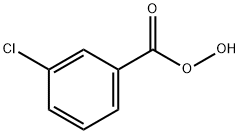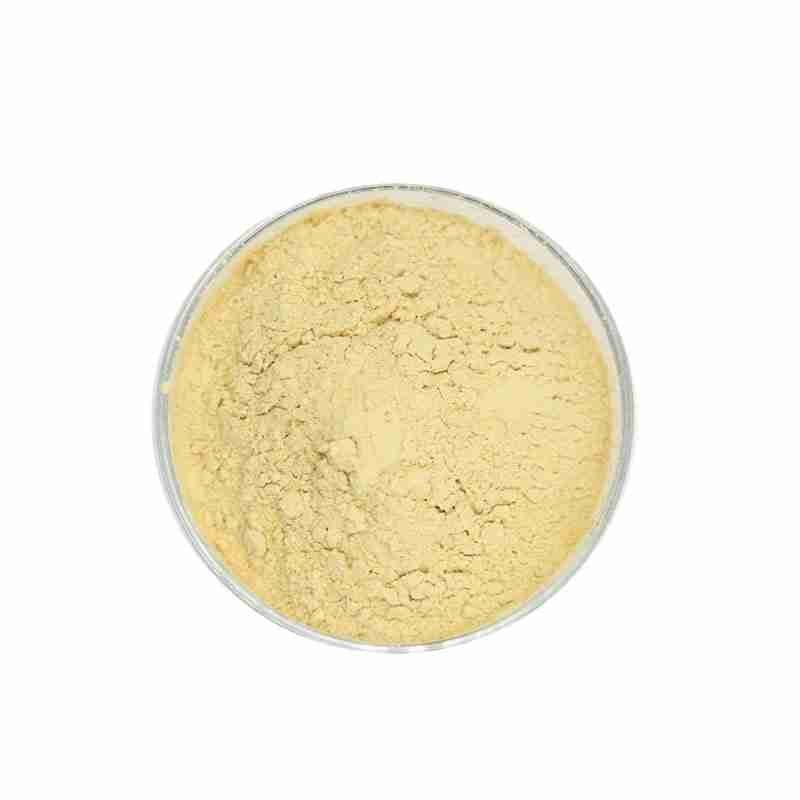3-Chloroperoxybenzoic Acid CAS# 937-14-4
3-Chloroperoxybenzoic acid (m-CPBA) is a carboxylic acid derivative, a white powder crystal, almost insoluble in water, conveniently soluble in ethanol, ether, soluble in chloroform, dichloroethane. Steady to warm, the annual disintegration price is listed below 1% at room temperature level. Disintegration rate is accelerated in liquid state.
In a polyethylene container, include 1.5 g of magnesium sulfate heptahydrate, 36g of sodium hydroxide, 360ml of water, 90ml of 30% hydrogen peroxide, 450ml of dioxane as well as ice cubes, reduced the temperature level to 15 ?? C, as well as include 52.5 g of M-chlorobenzoyl chloride, after that include ice to keep the temperature level listed below 25 ?? C. After reacting for 15 mins, include 900ml of 20% chilly sulfuric acid. After standing still, the organic layer was divided, filteringed system, and the filtrate was evaporated to eliminate the solvent (high vacuum cleaner distillation) to get 51g of 3-chloroperbenzoic acid.
发送询盘
3-Chloroperoxybenzoic Acid CAS# 937-14-4
| 3-Chloroperoxybenzoic acid Basic information |
| Chemical Properties?Uses |
| Product Name: | 3-Chloroperoxybenzoic acid |
| Synonyms: | 3-CHLOROPEROXYBENZOIC ACID;3-Chloroperoxy benzoic acid(more than 57% but not more than 86%,with 3-chorobenzoic acid);3-Chloroperoxybenzoic acid, balance 3-Chlorobenzoic acid and water, 70-75%;3-Chloroperoxybenzoic acid, 70 – 75%, (balance 3-chlorobenzoic acid and water);3-Chlorobenzeneperoxycarboxylic acid;3-Chloroperoxybenzoic Acid (contains min. 17% Water and min. 6% 3-Chlorobenzoic Acid);3-Chloroperoxybenzoic Acid (contains ca. 30% Water);3-Chloroperoxybenzoic acid ,75% |
| CAS: | 937-14-4 |
| MF: | C7H5ClO3 |
| MW: | 172.57 |
| EINECS: | 213-322-3 |
| Product Categories: | Organic Peroxide;Oxidation;Synthetic Organic Chemistry;Organic acids;PHARMACEUTICAL INTERMEDIATES;Aromatics;bc0001;top |
| Mol File: | 937-14-4.mol |
 |
|
| 3-Chloroperoxybenzoic acid Chemical Properties |
| Melting point | 69-71???C(lit.) |
| Boiling point | 244.67??C (rough estimate) |
| density | 0.56 |
| vapor pressure | 0.373Pa at 25?? |
| refractive index | 1.4580 (estimate) |
| storage temp. | 2-8??C |
| solubility | Chloroform (Slightly), Ethyl Acetate (Slightly), Methanol (Slightly) |
| pka | 7.57 (in water @ 25 ??C) |
| form | Moist Powder |
| color | White |
| PH | 4.5@25 ??C (saturated aq. sol) |
| Odor | slight pungent odor |
| Water Solubility | insoluble |
| Decomposition | >88 ??C |
| BRN | 608317 |
| Stability: | Strong oxidizing agent – contact with combustible material may cause fire. May be shock or heat sensitive. Incompatible with organic materials, strong reducing agents. |
| InChIKey | NHQDETIJWKXCTC-UHFFFAOYSA-N |
| LogP | 1.03 at 25?? |
| CAS DataBase Reference | 937-14-4(CAS DataBase Reference) |
| NIST Chemistry Reference | 3-Chloroperbenzoic acid(937-14-4) |
| EPA Substance Registry System | Benzenecarboperoxoic acid, 3-chloro- (937-14-4) |
- 2
- 2-diallylpent-4-en-1-amine
- 4
- 95-16-9
- Ammonium sulfamate
- Benzothiazole
- cas:67889-00-3ح2
- cas:83524-75-8 | pigment black 32
- cas:928836-00-4 | 2
- cas:932745-70-5 | 4
- Chemical Minerals
- Coconut diethanolamide
- Daily Chemicals
- discount
- for sale
- General pvc resin
- hexyl D-glucoside
- in stock
- Lauramidopropyl betaine
- LAURIC ACID MONOETHANOLAMIDE
- Petroleum Additives
- Plasticiser
- Ploymers
- price
- PVC
- quotation
- Raw Materal
- Remove term: Petroleum Additives Petroleum Additive
- SODIUM ETHYL 2-SULFOLAURATE
Related Products
Chemical Name: Potassium Castorate
CAS No.: 8013-05-6
Molecular Formula: C57H107K3O12
Molecular Weight: 1101.74718
Appearance: Yellow Liquid
Chemical Name: Zinc citrate
Synonyms: Zinc citrate trihydrate
CAS No.: 546-46-3
Molecular Formula: C6H8O7Zn
Molecular Weight: 257.5
Appearance: White powder
3,4-Ethylenedioxythiophene is a synthetic organic compound characterized by its unique structure that includes a thiophene ring with ethylenedioxy substituents at the 3 and 4 positions. This compound is known for its potential applications in the synthesis of various organic materials, including pharmaceuticals and organic electronic devices such as sensors and solar cells. Its stability and reactivity make it a versatile intermediate in the chemical industry.
Chemical Name: UV-120
Other Name: (2’,4’-Di-tert-butylphenyl 3,5-di-tert-butyl-4-hydroxybenzoate)
CAS No.: 4221-80-1
Molecular Fomula: C29H42O3
Molecular weight: 438.66
Assay: ≥99%(LC)
Tetraacetylethylenediamine is a fully acetylated derivative of ethylenediamine, offering a high reactivity as an intermediate in organic synthesis. Its unique structure makes it a critical component in the production of specialty chemicals and pharmaceuticals, ensuring a wide range of applications in the chemical industry.
Chemical Name: STODDARD SOLVENT
CAS No.: 64742-88-7
Appearance: Colorless or Light Yellow Liquid
Chemical Name: Arabic gum
CAS No.: 9000-01-5
Appearance: powder
Octocrylene is an organic compound widely recognized for its potent UV-filtering properties, making it an essential ingredient in sunscreens and other skincare products designed to protect the skin from harmful ultraviolet radiation. With the chemical name 2-(4-Methylbenzyl)-2H-benzotriazole-5-methyl, octocrylene is a stable and photostable molecule that provides broad-spectrum protection against both UVA and UVB rays.
This oil-soluble chemical is valued for its ability to absorb UV radiation effectively, converting it into heat without causing skin irritation or staining clothes. Octocrylene is often used in combination with other UV filters to enhance the sun protection factor (SPF) of formulations, ensuring a balanced and comprehensive defense against sun damage.
As a lipophilic compound, octocrylene is compatible with various cosmetic and dermatological formulations, contributing to the development of lightweight, non-greasy sunscreens. Its chemical structure allows for a high degree of safety and efficacy, making it suitable for a wide range of skin types, including sensitive skin.
In summary, octocrylene is a reliable and efficient UV filter, pivotal in the formulation of modern sunscreens that offer advanced protection against the sun’s harmful effects while maintaining skin comfort and product aesthetics.
Chemical Name: Imazalil Sulfate
CAS No.: 58594-72-2
Molecular Formula: C14H14Cl2N2O.H2SO4
Molecular Weight: 395.26
Appearance: Solid
Chemical Name: 3-Hydroxybutyric acid
CAS No.: 625-71-8
Molecular Formula: C4H8O3
Molecular Weight: 104.1
Appearance: White powder
Polyhexamethylene guanidine hydrochloride, often abbreviated as PHMG-HCl, is a high molecular weight polymeric biguanide compound known for its potent antimicrobial properties. With a chemical structure that features a long chain of methylene groups bridged by guanidine units, PHMG-HCl is effective against a broad spectrum of microorganisms, including bacteria, viruses, and fungi.
This hydrochloride salt form of PHMG is highly soluble in water and is commonly used in various applications due to its non-irritant and non-toxic nature to human skin and mucous membranes. It is widely recognized for its ability to form a colorless and odorless solution, making it an ideal choice for use in personal care products, medical disinfectants, and water treatment processes.
The versatility of PHMG-HCl lies in its cationic nature, which allows it to bind to negatively charged microbial cell walls, disrupting their integrity and leading to cell death. This mechanism of action contributes to its effectiveness as a preservative and disinfectant. Moreover, its substantivity, or the ability to adhere to surfaces, enhances its long-lasting antimicrobial activity.
In summary, Polyhexamethylene guanidine hydrochloride is a reliable and efficient antimicrobial agent, pivotal in industries where hygiene and cleanliness are paramount, offering a safe and sustainable solution for microbial control.
Common English name: 5-iodo-2,3-dihydropyridazin-3-one
CAS No.: 825633-94-1
Molecular formula: C4H3IN2O
Molecular weight: 221.98
Sample: Available



















